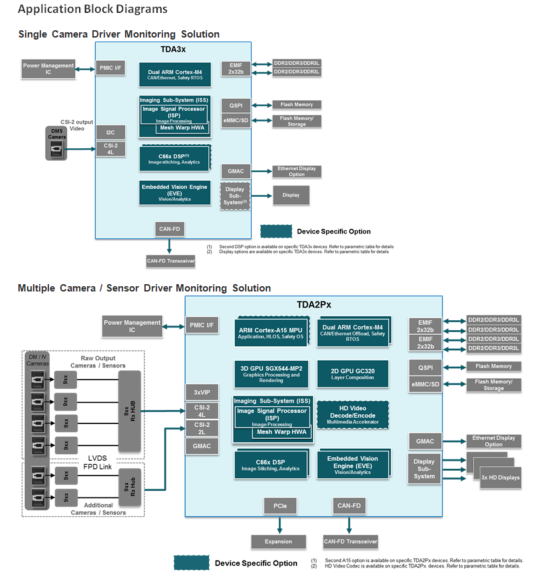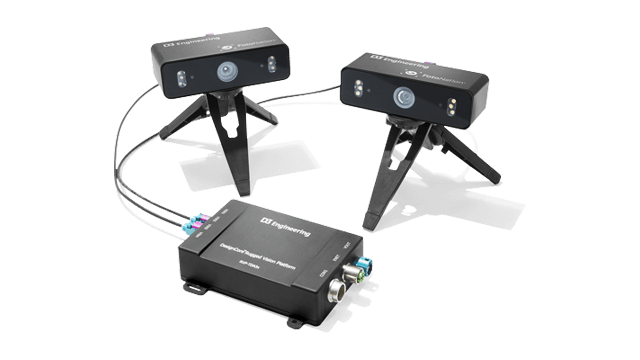SSZT567 december 2018
Driver monitoring systems (DMS) are enhancing real-time feedback to a vehicle’s steering and control systems, as discussed in our recent post, “How driver monitoring systems can help with collision avoidance.” However, there are several key design considerations when designers begin incorporating this technology into vehicles.
Typically when designing a system for a controlled environment where the light source is calibrated for optimal image quality, the design challenges are simplified. The size and form factor of the DMS platform are not major constraints and there are no strict limits to power consumption or thermal dissipation. The primary design consideration in DMS is the robustness and accuracy of the algorithm used in the system.
You may think the interior of a vehicle can be called a reasonably defined environment, but in reality, it’s far from it. The interior of a vehicle is actually quite an unpredictable environment. Typical constraints include, but are not limited to, driving environmental unpredictability caused by changing light exposure, reflections from oncoming headlight beams and changes in ambient temperature.
These factors drive the need for systems to include sufficient algorithms capable of handling tough environmental conditions. Another factor that adds to the system complexity is accommodating the cosmetic design of the vehicle. Automotive designers constantly try to introduce new design concepts while also maximizing driver comfort features. These constraints require the position and location of the DMS camera to often change.
In practice, DMS designers need to consider the following:
- DMS must provide quality images for reliable vision processing even in low light conditions, such as nighttime, tunnels or inclement weather.
- The camera position has the flexibility to be installed anywhere on the instrument cluster, steering column, a pillar or rearview mirror depending on interior configurations.
- DMS solutions can function either as standalone designs or something that can be integrated into a larger cluster or infotainment ECU.
- Since DMS solutions can be linked to functional safety-critical ADAS and autonomous driving functions, additional system assessment and ASIL certification may be needed.
Meeting these system challenges require the SoC to provide:
- Sufficient performance to compute complex, computer vision and artificial intelligence algorithms
- Flexibility to interface new sensors and support different system topologies such as standalone single box design to an integrated cluster/infotainment + DMS solution ECU with far reach sensors
- Low power consumption to accommodate small form factor designs, a critical requirement to be placed anywhere in the vehicle
- Functional safety and automotive ready
A system on chip (SoC) solution, like a TDA3x processor as shown in Figure 1, brings new innovations to DMS systems by offering an optimized solution for vision and sensor processing in a small form factor and low power design. Jacinto™ 6 automotive processors, like the TDA3x family, provide a scalable portfolio of SoCs that enable developers to meet a broad range of performance and system needs while keeping a common software base.
Using the TDA3x SoC, DMS solutions can help provide:
- Enhanced image quality – Advanced Image Signal Processor (ISP) on TDA3x processors enables advanced sensor perception with enhanced support for image sensors such as global shutter, RGB-IR and rolling shutter sensors. This means that the DMS solution can effectively adjust to changing light exposure and filter system noise resulting in superior image quality.
- Thermal reductions – TDA3 heterogeneous architecture leverages the integrated embedded vision engine (EVE) and C66x DSP enabling efficient software execution at lower power (<2.5W) reducing heat dissipation.
- More flexible camera positioning – The small footprint of the TDA3x device allows developers to accommodate PCB designs that integrate the imager, IR LED, power and memory. Alternatively, developers can utilize a central computing PCB with remote LVDS-connected cameras to enable smaller camera-only modules for positioning in more space-constrained locations with the vehicle.
 Figure 1 System block diagram of TDA3x
and TDA2Px devices for DMS.
Figure 1 System block diagram of TDA3x
and TDA2Px devices for DMS.Development kits can also help designers get started developing their DMS solution quickly. The D3 Engineering DMS kit, as shown in Figure 1, combines the TDA3x automotive processor with camera modules and vision algorithms to help engineers evaluate the technology and develop DMS applications.
The DMS kit, available from D3 Engineering includes a DesignCore® RVP-TDA3x Rugged Vision Platform ECU features a TDA3x System-on-Module (SOM) board, associated firmware and customizable baseboard in a rugged enclosure. Two D3CM camera modules (D3CM), enable driver monitoring and iris tracking. The cameras incorporate 2MP sensors, IR illumination for reliable operation in various lighting conditions (per TI’s published specification), and an RGB LED for user feedback during system development.
 Figure 2 D3 Engineering Kit for
DMS.
Figure 2 D3 Engineering Kit for
DMS.FotoNation algorithms are optimized to run on the ECU and the FotoNation application library includes eye gaze tracking, face detection, head position tracking, and 3D facial feature detection. In addition to the autonomous driving and ADAS functions, engineers can develop in-cabin security and customization features based on driver identity using the face and iris recognition functionality.
The D3 DMS kit supports Level 2 and Level 3 semi-autonomous vehicles, ensuring that the driver is capable of taking over as needed. This kit supports additional use cases like operator authentication, awareness, and drowsiness detection in both industrial and semi-autonomous automotive systems.
The DMS kit is suitable for on-vehicle or field testing. It supports development of engineering verification test (EVT) units and automotive A-Samples with the support of D3 Engineering’s product development services. It is intended to provide a path to production for both integrated-dashboard and after-market DMS solutions.
Drowsiness and driver distractions have surfaced as a major safety issue worldwide. DMS technology can help detect distracted and potentially drowsy drivers by accurately measuring head and eye positions to classify driver attention and fatigue. TDA processors enable state-of-the-art DMS solutions with artificial intelligence (AI) and computer vision processing in low power processing at the edge, allowing tomorrow's vehicles to be better equipped on the road.
Additional Resources:
- Read: Understanding how driver monitoring systems can help with collision avoidance, part 1
- Learn more about driver monitoring systems.
- Discover TDA3x automotive processors.
- Get started developing your own DMS with D3 Engineering’s driver monitoring system kit.